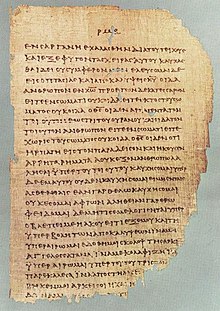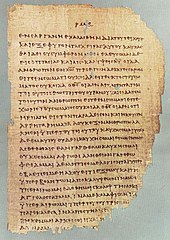The Pauline epistles, Epistles of Paul, or Letters of Paul, are the thirteen New Testament books which have the name Paul (Παῦλος) as the first word, hence claiming authorship by Paul the Apostle. Among these letters are some of the earliest extant Christian documents. They provide an insight into the beliefs and controversies of early Christianity and as part of the canon of the New Testament they are foundational texts for both Christian theology and ethics. The Epistle to the Hebrews, although it does not bear his name, was traditionally considered Pauline for a thousand years, but from the 16th century onwards opinion steadily moved against Pauline authorship and few scholars now ascribe it to Paul, mostly because it doesn't read like any of his other epistles in style and content. Most scholars agree that Paul really wrote seven of the Pauline epistles, but that four of the epistles in Paul's name are pseudepigraphic; scholars are divided on the authenticity of two of the epistles.
The Pauline epistles are usually placed between the Book of Acts and the General epistles in modern editions. Most Greek manuscripts, however, place the General epistles first, and a few minuscules (175, 325, 336, and 1424) place the Pauline epistles at the end of the New Testament.
Order

In the order they appear in the New Testament, the Pauline epistles are:
This ordering is remarkably consistent in the manuscript tradition, with very few deviations. The evident principle of organization is descending length of the Greek text, but keeping the four Pastoral epistles addressed to individuals in a separate final section. The only anomaly is that Galatians precedes the slightly longer Ephesians.
In modern editions, the formally anonymous Epistle to the Hebrews is placed at the end of Paul's letters and before the General epistles. This practice was popularized through the 4th-century Vulgate by Jerome, who was aware of ancient doubts about its authorship, and is also followed in most medieval Byzantine manuscripts. With hardly any exceptions, though, the manuscripts do include Hebrews somewhere among Paul's letters.
The placement of Hebrews among the Pauline epistles is less consistent in the manuscripts:
- between Romans and 1 Corinthians (i.e., in order by length without splitting the Epistles to the Corinthians): Papyrus 46 and minuscules 103, 455, 1961, 1964, 1977, 1994.
- between 2 Corinthians and Galatians: minuscules 1930, 1978, and 2248
- between Galatians and Ephesians: implied by the numbering in B
- between 2 Thessalonians and 1 Timothy (i.e., before the Pastorals): ×, A, B, C, H, I, P, 0150, 0151, and about 60 minuscules (e.g. 218, 632)
- after Philemon: D, 048, E, K, L and the majority of minuscules.
- omitted: F and G
Authenticity

In all of these epistles, Paul does claim to be the author and writer. However, the contested letters may have been forgeries, as that seems to have been a problem among the early church as a whole
Seven letters (with consensus dates) considered genuine by most scholars:
- First Thessalonians (ca. 51 AD)
- Philippians (ca. 52â€"54 AD)
- Philemon (ca. 52â€"54 AD)
- First Corinthians (ca. 53â€"54 AD)
- Galatians (ca. 55 AD)
- Second Corinthians (ca. 55â€"56 AD)
- Romans (ca. 55â€"58 AD)
The letters thought to be pseudepigraphic by about 80% of scholars:
- First Timothy
- Second Timothy
- Titus
- Ephesians
The letters on which scholars are about evenly divided:
- Colossians
- Second Thessalonians
Lost Pauline epistles

- A first epistle to Corinth, referenced at 1 Corinthians 5:9
- A third epistle to Corinth, also called the Severe Letter, referenced at 2 Corinthians 2:4 and 2 Corinthians 7:8â€"9
- An earlier epistle to the Ephesians referenced at Ephesians 3:3â€"4
- The Epistle to the Laodiceans, referenced at Colossians 4:16
Non-canonical Pauline epistles
Several non-canonical epistles claim or having been claimed to have been written by Paul. Most bible scholars reject their authenticity.
- Third Epistle to the Corinthians (canonical for a time in the Armenian Apostolic Church)
- Epistle to the Laodiceans (found in Codex Fuldensis)
- Epistle of the Corinthians to Paul
- Epistle to the Alexandrians
Texts also exist which, while not strictly epistles, nevertheless claim to have been written by (or about) Paul.
- Acts of Paul and Thecla
- Acts of Peter and Paul
- Apocalypse of Paul
- Coptic Apocalypse of Paul
- Prayer of the Apostle Paul
- Epistle to Seneca the Younger
See also
- New Testament athletic metaphors
- New Testament military metaphors
References
- ^ The New Jerome Biblical Commentary, publ. Geoffrey Chapman, 1989, chapter 60, at p.920, col. 2 "That Paul is neither directly nor indirectly the author is now the view of scholars almost without exception. For details, see Kümmel, I[ntroduction to the] N[ew] T[estament, Nashville, 1975] 392-94, 401-3"
- ^ Metzger, Bruce M. (1987). The Canon of the New Testament: Its Origin, Development, and Significance. pp. 295â€"296. ISBN 0198261802.Â
- ^ a b Trobisch, David (1994). Paul's Letter Collection: Tracing the Origins. pp. 1â€"27. ISBN 0800625978.Â
- ^ Joseph Barber Lightfoot in his Commentary on the Epistle to the Galatians writes: "At this point [Gal 6:11] the apostle takes the pen from his amanuensis, and the concluding paragraph is written with his own hand. From the time when letters began to be forged in his name (2Â Thess 2:2; 3:17) it seems to have been his practice to close with a few words in his own handwriting, as a precaution against such forgeries... In the present case he writes a whole paragraph, summing up the main lessons of the epistle in terse, eager, disjointed sentences. He writes it, too, in large, bold characters (Gr. pelikois grammasin), that his handwriting may reflect the energy and determination of his soul."
- ^ Pheme Perkins, Reading the New Testament: An Introduction (Paulist Press, 1988), pp. 4â€"7.
- ^ a b New Testament Letter Structure, from Catholic Resources by Felix Just, S.J.
- ^ Also called A Prior Epistle of Paul to the Corinthians[1] or Paul’s previous Corinthian letter.[2], possibly Third Epistle to the Corinthians
- ^ Apologetics Press â€" Are There Lost Books of the Bible?
Bibliographic resources

- Aland, Kurt. “The Problem of Anonymity and Pseudonymity in Christian Literature of the First Two Centuries.†Journal of Theological Studies 12 (1961): 39â€"49.
- Bahr, Gordon J. “Paul and Letter Writing in the First Century.†Catholic Biblical Quarterly 28 (1966): 465â€"77. idem, “The Subscriptions in the Pauline Letters.†Journal of Biblical Literature 2 (1968): 27â€"41.
- Bauckham, Richard J. “Pseudo-Apostolic Letters.†Journal of Biblical Literature 107 (1988): 469â€"94.
- Carson, D.A. “Pseudonymity and Pseudepigraphy.†Dictionary of New Testament Background. Eds. Craig A. Evans and Stanley E. Porter. Downers Grove: InterVarsity, 2000. 857-64.
- Cousar, Charles B. The Letters of Paul. Interpreting Biblical Texts. Nashville: Abingdon, 1996.
- Deissmann, G. Adolf. Bible Studies. Trans. Alexander Grieve. 1901. Peabody: Hendrickson, 1988.
- Doty, William G. Letters in Primitive Christianity. Guides to Biblical Scholarship. New Testament. Ed. Dan O. Via, Jr. Philadelphia: Fortress, 1988.
- Gamble, Harry Y. “Amanuensis.†Anchor Bible Dictionary. Vol. 1. Ed. David Noel Freedman. New York: Doubleday, 1992.
- Haines-Eitzen, Kim. “‘Girls Trained in Beautiful Writing’: Female Scribes in Roman Antiquity and Early Christianity.†Journal of Early Christian Studies 6.4 (1998): 629â€"46.
- Kim, Yung Suk. A Theological Introduction to Paul's Letters. Eugene, Oregon: Cascade Books, 2011.
- Longenecker, Richard N. “Ancient Amanuenses and the Pauline Epistles.†New Dimensions in New Testament Study. Eds. Richard N. Longenecker and Merrill C. Tenney. Grand Rapids: Zondervan, 1974. 281-97. idem, “On the Form, Function, and Authority of the New Testament Letters.†Scripture and Truth. Eds. D.A. Carson and John D. Woodbridge. Grand Rapids: Zondervan, 1983. 101-14.
- Murphy-O’Connor, Jerome. Paul the Letter-Writer: His World, His Options, His Skills. Collegeville, MN: Liturgical, 1995.
- Richards, E. Randolph. The Secretary in the Letters of Paul. Tübingen: Mohr, 1991. idem, “The Codex and the Early Collection of Paul’s Letters.†Bulletin for Bulletin Research 8 (1998): 151â€"66. idem, Paul and First-Century Letter Writing: Secretaries, Composition, and Collection. Downers Grove: InterVarsity, 2004.
- Robson, E. Iliff. “Composition and Dictation in New Testament Books.†Journal of Theological Studies 18 (1917): 288â€"301.
- Stowers, Stanley K. Letter Writing in Greco-Roman Antiquity. Library of Early Christianity. Vol. 8. Ed. Wayne A. Meeks. Philadelphia: Westminster, 1989.
- Wall, Robert W. “Introduction to Epistolary Literature.†New Interpreter’s Bible. Vol. 10. Ed. Leander E. Keck. Nashville: Abingdon, 2002. 369-91.
External links

- The Marcionite Prologues to the Pauline Epistles
- Chronological Order of Paul's Letters
- Chronology of Paul's Letters
_folio_18.jpg/220px-Minuscule_699_(GA)_folio_18.jpg)
